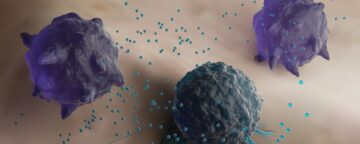Shelby Bradford in The Scientist:
 Cellular communication is vital for passing information to neighboring cells. One key messenger in this process is an exosome, a nanosized particle that buds off from a progenitor cell, carrying molecular cargo. Because these small, cellular vehicles carry contents from their parent cells, exosomes can serve as snapshots for a given population of cells, including tumors.
Cellular communication is vital for passing information to neighboring cells. One key messenger in this process is an exosome, a nanosized particle that buds off from a progenitor cell, carrying molecular cargo. Because these small, cellular vehicles carry contents from their parent cells, exosomes can serve as snapshots for a given population of cells, including tumors.
“If you can sample a vesicle, or any entity, from blood, it gives you a huge advantage, being a low or minimally invasive strategy to monitor cancer or detect cancer,” said David Greening, a biologist who studies extracellular vesicles like exosomes at La Trobe University. One strategy to improve the use of exosomes as cancer biomarkers is to identify surface proteins on these vesicles that reflect their originating tumor.1 L-type amino acid transporter 1 (LAT1), a surface protein that shuttles large amino acids into the cell, is predominantly associated with cancerous cells and correlates with tumor severity.2,3 These characteristics made the protein an attractive target for therapeutic intervention, with one LAT1 inhibitor currently undergoing clinical trials.4
More here.
Enjoying the content on 3QD? Help keep us going by donating now.
